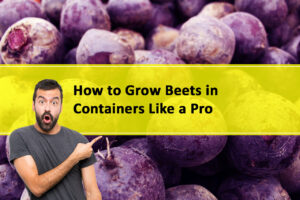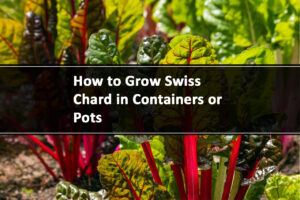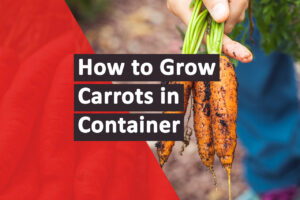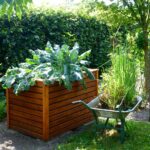Beautiful Plants For Your Interior
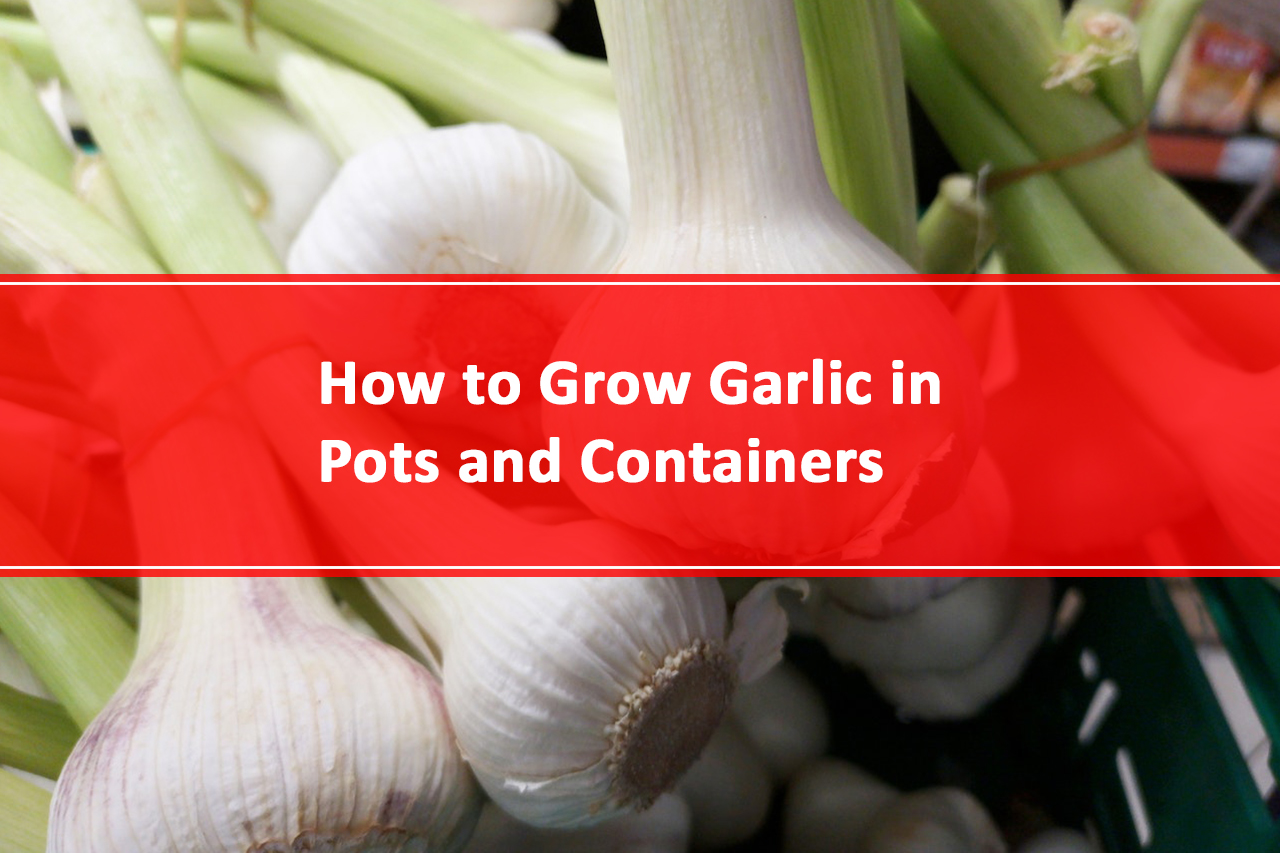
How to Grow Garlic in Pots and Containers
Garlic, with its pungent aroma and distinctive flavor, is a kitchen essential in many culinary traditions worldwide. What if you don’t have a spacious garden or outdoor plot? The good news is that you can successfully grow garlic in pots and containers.
Growing garlic in pots and containers is an excellent way to enjoy this flavorful and nutritious herb, even if you have limited garden space. Whether you’re an urban gardener with only a balcony or someone looking to keep garlic closer to the kitchen, this guide will walk you through the steps to successfully cultivate garlic in pots.
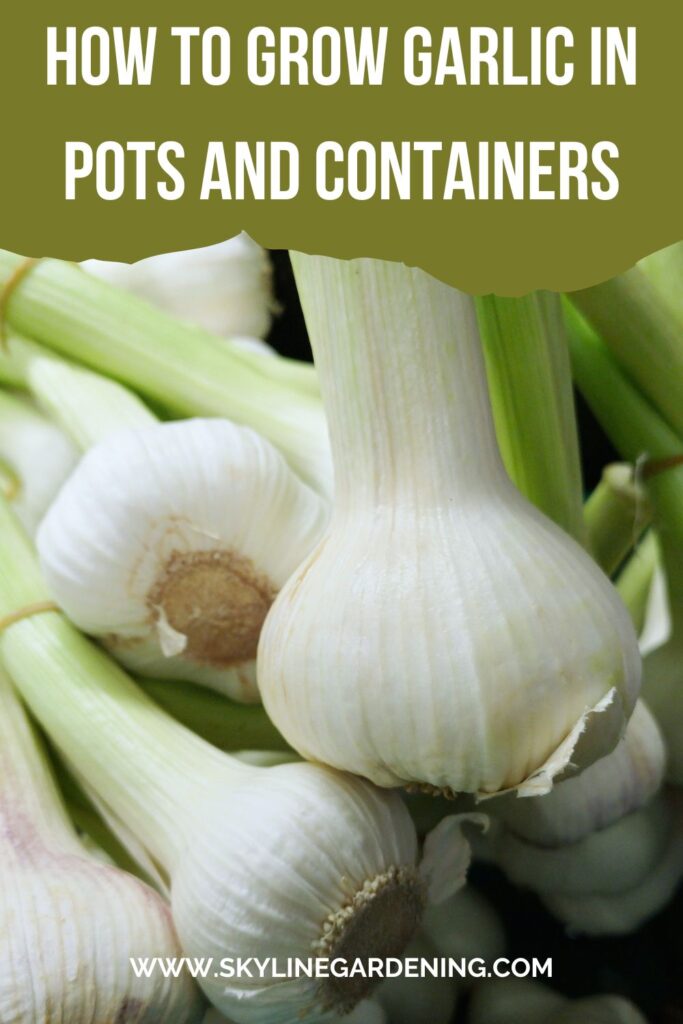
1. Choosing the Right Container for Growing Garlic in Pots
Choose a container material that suits your climate and gardening preferences. Regardless of the material, ensure that the container has drainage holes to prevent water from accumulating at the bottom.
The Significance of Container Selection
When it comes to growing garlic in pots, choosing the right container is the first crucial step. Containers play a pivotal role in the success of your garlic crop. Here’s what you need to consider:
Container Size and Depth Requirements
Garlic plants need adequate space for their roots to develop. Therefore, select containers that are at least 8-10 inches (20-25 cm) deep. This depth allows for proper root growth and prevents crowding, which can hinder bulb development.
Container Materials: Clay, Plastic, Wood, or Fabric
The choice of container material affects the growing environment for your garlic. Here’s a brief overview of common container materials:
- Clay Pots: Clay pots are porous, allowing excess moisture to escape. This can be beneficial in preventing overwatering and root rot. However, they can also dry out quickly in hot weather, requiring more frequent watering.
- Plastic Containers: Plastic containers are lightweight and retain moisture well. They are less prone to drying out but may require proper drainage to prevent waterlogging.
- Wooden Boxes or Crates: Wooden containers provide a rustic look and can work well for garlic. Ensure they are well-sealed to prevent rapid moisture loss.
- Fabric Pots: Fabric pots are breathable and offer excellent drainage. They are an excellent choice for garlic, as they prevent overwatering and promote healthy root development.
2. Selecting the Perfect Garlic Variety for Container Gardening
When selecting a garlic variety, you must consider factors such as flavor, bulb size, and adaptability to your climate. It’s also a good idea to purchase garlic bulbs from reputable sources or local farmers to ensure they are well-suited to your growing conditions.
Softneck vs. Hardneck Garlic: Which Is Ideal for Pots?
Before you start planting garlic in containers, it’s essential to understand the two main types of garlic: softneck and hardneck.
- Softneck Garlic: Softneck garlic is a popular choice for its long shelf life and versatility in the kitchen. It typically produces more cloves per bulb, making it a good option for container gardening. Softneck varieties are well-suited to milder climates.
- Hardneck Garlic: Hardneck garlic varieties are known for their robust flavor and larger cloves. While they can be grown in containers, they thrive in colder climates. Hardneck garlic produces a central stalk known as a scape, which is edible and adds a unique flavor to dishes.
The choice between softneck and hardneck garlic ultimately depends on your location and flavor preferences. If you’re in a region with harsh winters, hardneck varieties may be better suited for overwintering in containers.
Recommended Garlic Varieties for Containers
Certain garlic varieties are particularly well-suited for container gardening due to their compact growth habits. Some popular choices include:
- Lorz Italian: A softneck variety with large cloves and a mild flavor.
- Inchelium Red: Another softneck variety with a sweet and mild taste.
- Music: A hardneck garlic known for its robust flavor and easy-to-peel cloves.
- Spanish Roja: A hardneck garlic with a rich, full-bodied flavor.
3. Preparing the Potting Mix for Container Garlic
Optimal Soil Composition for Garlic
To successfully grow garlic in pots, you’ll need to create the right growing medium. Garlic thrives in well-draining, fertile soil. Here’s how to prepare the ideal potting mix:
Ingredients for a Garlic-Friendly Potting Mix:
- Potting Soil: Start with a high-quality potting mix, which provides the necessary structure and nutrients for your garlic plants.
- Compost: Add well-rotted compost to enrich the soil with organic matter. Compost improves soil structure, enhances nutrient retention, and encourages beneficial microorganisms.
- Perlite or Vermiculite: Incorporate perlite or vermiculite to improve drainage and aeration in the potting mix.
Mixing Your Potting Mix:
- In a large container or wheelbarrow, combine the potting soil, compost, and perlite or vermiculite in a ratio of approximately 2:1:1. Adjust the proportions as needed to achieve a well-balanced mix.
- Thoroughly blend the components until you have a uniform potting mix.
- Fill your chosen container with the potting mix, leaving about an inch (2.5 cm) of space at the top to prevent soil from spilling over when watering.
Ensuring Proper Drainage and Aeration
Garlic plants dislike waterlogged soil, which can lead to root rot. To prevent this, ensure that your chosen container has adequate drainage holes at the bottom. Elevate the container slightly on bricks or pot feet to further improve drainage.
In addition to drainage, garlic roots also require oxygen for healthy growth. Proper aeration is achieved by adding perlite or vermiculite to the potting mix, as mentioned earlier. This ensures that the soil doesn’t become compacted and allows roots to access oxygen.
4. Planting Garlic in Pots
When and Where to Plant Garlic
Garlic is typically planted in the fall, but the exact timing depends on your climate zone. Planting in the fall allows the garlic cloves to establish roots before winter, leading to robust growth in the spring.
Here are some general guidelines for planting garlic in pots:
- Cooler Climates (Zone 5 and below): Plant garlic in late September to early October, before the ground freezes.
- Moderate Climates (Zone 6-8): Plant garlic in mid-to-late October.
- Warmer Climates (Zone 9 and above): Garlic can be planted in late fall or even early winter.
Choose a sunny location for your container, as garlic requires at least six hours of direct sunlight daily for optimal growth.
Spacing and Depth Guidelines for Garlic in Containers
Proper spacing is crucial to allow each garlic bulb enough room to grow. Here’s how to space and plant your garlic cloves:
- Measure the diameter of your container to determine the number of garlic cloves you can plant. For a 10-inch (25 cm) container, you can typically plant three to five cloves.
- Space the cloves about 4-6 inches (10-15 cm) apart within the container. This spacing provides enough room for the bulbs to develop without crowding.
- Plant each garlic clove with the pointed end facing upward, about 1-2 inches (2.5-5 cm) below the soil surface. Press them firmly into the soil but avoid compacting it excessively.
Planting Individual Garlic Cloves for Optimal Growth
Garlic bulbs are made up of individual cloves, each of which can grow into a new garlic plant. When planting garlic in containers, it’s best to use individual cloves rather than planting the entire bulb. Here’s how to prepare and plant garlic cloves:
- Separate the cloves from the garlic bulb just before planting. Be gentle to avoid damaging the cloves.
- Choose the largest and healthiest cloves for planting, as they are more likely to produce robust plants and bulbs.
- Plant each clove as described in the previous section, ensuring that the pointed end faces upward.
By planting individual cloves, you allow each one to develop into a full-sized bulb. This method also allows for better spacing within the container.
5. Watering and Mulching for Container-Grown Garlic
Best Practices for Watering Garlic in Containers
Proper watering is essential for growing garlic in pots. Garlic plants prefer consistently moist soil but can suffer from root rot if overwatered. Here’s how to strike the right balance:
Watering Frequency:
- Water your container-grown garlic when the top inch (2.5 cm) of soil feels dry to the touch. Use your finger to check soil moisture regularly.
- In hot and dry weather, you may need to water more frequently, possibly every 2-3 days. In cooler or rainy conditions, reduce the frequency to prevent overwatering.
- Avoid letting the soil dry out completely between waterings, as this can stress the garlic plants.
Watering Technique:
- Water the soil at the base of the plants rather than overhead to minimize the risk of fungal diseases and rot.
- Use a gentle stream of water to prevent soil erosion and damage to the garlic shoots.
- Water early in the day to allow the soil to dry before evening, reducing the risk of fungal issues.
The Role of Mulch in Container Gardening
Mulching is a beneficial practice for container-grown garlic. Mulch helps conserve soil moisture, suppress weeds, and maintain more consistent soil temperatures. Here’s how to apply mulch effectively:
- Mulch Thickness: Apply a layer of mulch, such as straw or shredded leaves, about 2-3 inches (5-7.5 cm) thick on the soil surface. Leave a small gap around the base of each garlic plant to prevent moisture-related issues.
- Mulch Renewal: Check the mulch periodically and replenish it as needed to maintain the desired thickness.
- Mulch Types: Organic mulches like straw and leaves break down over time, enriching the soil with organic matter. They are ideal for garlic grown in containers.
Mulching also helps regulate soil temperature, preventing extreme temperature fluctuations that can stress garlic plants.
Avoiding Overwatering and Root Rot
Overwatering is a common mistake in container gardening, and it can lead to root rot in garlic. To prevent overwatering:
- Use well-draining soil and containers with drainage holes.
- Monitor soil moisture regularly and adjust your watering schedule as needed.
- If you notice signs of overwatering, such as wilting leaves and yellowing, reduce the frequency of watering immediately.
Proper watering and mulching practices will help ensure the health and vigor of your container-grown garlic.
6. Fertilizing and Care for Container Garlic
Understanding Fertilizers’ Role in Garlic Growth
Garlic, like all plants, requires essential nutrients for healthy growth. In containers, nutrients can become depleted more quickly, so it’s essential to provide appropriate fertilization. Here’s what you need to know:
- Essential Nutrients: Garlic primarily requires nitrogen, phosphorus, and potassium (N-P-K) in balanced proportions. Nitrogen encourages leafy growth, while phosphorus and potassium support root development and bulb formation.
- Organic Fertilizers: Organic fertilizers, such as compost and well-rotted manure, are excellent choices for container garlic. They release nutrients gradually and improve soil structure.
- Synthetic Fertilizers: If you prefer using synthetic fertilizers, choose a balanced, slow-release formula with an N-P-K ratio of around 10-10-10 or 14-14-14.
Feeding Schedule and Recommended Fertilizers
Here’s a feeding schedule to follow when growing garlic in pots:
- Pre-Planting: Before planting garlic cloves, mix a balanced granular fertilizer into the potting mix according to the manufacturer’s instructions. This provides essential nutrients for initial growth.
- Early Spring: In late winter or early spring, when your garlic plants start emerging, apply a balanced, slow-release fertilizer around the base of each plant. Follow the recommended application rates on the fertilizer packaging.
- Mid-Spring: As the garlic plants continue to grow, provide a second application of fertilizer to support bulb development. Ensure that you water the plants after fertilizing to help nutrients penetrate the soil.
- Cease Fertilization: Stop fertilizing garlic approximately two months before the expected harvest date. This allows the bulbs to mature and prevents the development of excess foliage at the expense of bulb growth.
Always follow the specific guidelines on the fertilizer packaging and avoid over-fertilizing, as this can lead to nutrient imbalances and plant stress.
Monitoring Pests and Diseases
Container gardening can reduce the risk of some pests and diseases that affect garlic, but vigilance is still necessary. Keep an eye out for common garlic issues:
- Aphids: These small, soft-bodied insects can be removed by spraying garlic plants with a strong stream of water. You can also use insecticidal soap if the infestation is severe.
- White Rot: White rot is a fungal disease that affects garlic. To prevent it, avoid planting garlic in the soil where other alliums (e.g., onions, leeks) have grown recently.
- Garlic Rust: Garlic rust appears as orange or yellow spots on the leaves. Remove affected leaves promptly and practice good garden hygiene to reduce the spread of the disease.
By monitoring your container garlic regularly and taking preventive measures, you can minimize the risk of pests and diseases.
7. Managing Growth and Development of Garlic in Containers
Understanding Garlic’s Growth Stages
To successfully grow garlic in pots, it’s essential to understand the plant’s growth stages. Garlic goes through several phases:
1. Germination:
- This stage occurs immediately after planting, as the garlic cloves start to send out roots and shoots.
- It usually takes 1-2 weeks for the first green shoots to emerge from the soil.
2. Vegetative Growth:
- During this phase, garlic focuses on developing foliage, which is essential for photosynthesis and bulb growth.
- Leaves will continue to grow throughout the early and mid-spring months.
3. Bulb Formation:
- As the days lengthen and the plant receives more sunlight, it shifts its energy toward forming bulbs.
- This phase typically occurs in late spring and early summer.
4. Maturation:
- Maturation is the final stage when the garlic bulbs reach their full size and flavor.
- The bulbs are ready for harvest in mid to late summer, depending on your climate.
Tackling Common Growth Challenges
Container gardening can present unique challenges, but with proper care, you can overcome them:
- Limited Space: Garlic adapts well to container gardening, making it a suitable choice for small spaces.
- Pest Management: Monitor your garlic regularly for signs of pests and take action as needed to prevent infestations from spreading.
- Frequent Watering: Container plants may require more frequent watering, especially in hot weather. Be mindful of soil moisture levels.
- Balancing Nutrients: Container plants rely on you for nutrients, so ensure they receive balanced fertilization throughout their growth stages.
Dealing with Scapes and Flowering
During the garlic plant’s growth, you may notice the emergence of scapes. Scapes are curly, green shoots that develop from hardneck garlic varieties. While they are visually interesting and edible, they can also divert energy away from bulb development.
To encourage larger bulb growth, consider removing the scapes when they curl, but before they straighten out completely. You can use these scapes in various culinary dishes to add a mild garlic flavor.
8. Harvesting Container-Grown Garlic
Signs Indicating Garlic Is Ready for Harvest
Harvesting garlic at the right time is crucial to ensure optimal flavor and storage life. Here are signs that your container-grown garlic is ready for harvest:
- Yellowing Leaves: As garlic matures, its leaves will start to turn yellow and wither. This is a natural sign that the bulbs are nearing maturity.
- Paper-Like Skins: When you gently push aside the soil around a garlic bulb, you should see papery skins covering the cloves. These skins become more apparent as the bulbs mature.
- Visible Bulbs: Depending on the variety, you may see the tops of the garlic bulbs emerging from the soil. This is another indication that they are ready for harvest.
- Timing: Harvest garlic when about 50-60% of the leaves have turned yellow. This typically occurs in mid-to-late summer, but it can vary based on your location and climate.
Harvesting Garlic Bulbs and Scapes
To harvest your container-grown garlic, follow these steps:
- Use a garden fork or trowel to gently loosen the soil around the garlic bulbs. Be careful not to damage the bulbs during this process.
- Once the bulbs are loose, carefully lift them from the container. Shake off excess soil, but avoid removing the papery outer skins.
- Trim the roots and excess foliage from each bulb, leaving about an inch (2.5 cm) of stem attached. This makes handling and curing easier.
- If you’ve allowed your hardneck garlic to produce scapes, you can harvest them before or after the bulbs. Cut the scapes about an inch (2.5 cm) above the topmost leaf.
9. Troubleshooting Common Issues
Addressing Yellowing Leaves and Nutrient Deficiencies
Yellowing leaves on your garlic plants can be indicative of various issues, including:
- Nutrient Deficiencies: Yellowing leaves may signal a lack of essential nutrients. Ensure you are providing adequate fertilization throughout the growing season.
- Overwatering: Excess moisture in the soil can lead to yellowing leaves. Adjust your watering schedule to maintain consistent, but not excessive, soil moisture.
- Pests and Diseases: Check for signs of pest damage or diseases, as they can affect leaf health. Promptly address any issues you identify.
Dealing with Garlic Pests and Diseases
Garlic can fall prey to certain pests and diseases, but timely intervention can help you manage these problems:
- Aphids: As mentioned earlier, aphids can be controlled by spraying your garlic plants with water or using insecticidal soap.
- White Rot: There is no effective treatment for white rot once it infects garlic. Prevent it by practicing crop rotation and ensuring good soil drainage.
- Garlic Rust: Remove affected leaves and practice good garden hygiene to prevent the spread of rust.
Environmental Factors Affecting Garlic Growth
Container gardening allows for better control of environmental factors, but you should still be aware of potential challenges:
- Temperature Extremes: Garlic is relatively cold-tolerant but can suffer in extreme heat or cold. Provide shade during hot spells and protect your containers from frost in colder climates.
- Inconsistent Watering: Container plants are susceptible to drying out quickly, so maintain a consistent watering schedule to avoid stress.
- Inadequate Sunlight: Ensure your garlic containers receive at least six hours of direct sunlight daily. Consider using reflective surfaces to maximize light exposure.
10. Tips and Tricks for Growing Garlic in Pots
Companion Planting with Garlic in Containers
Companion planting can help deter pests and improve the overall health of your container garden. Consider planting garlic alongside these companions:
- Lettuce: The scent of garlic can deter lettuce-loving pests like aphids.
- Carrots: Garlic may help repel carrot rust flies, which can damage carrot crops.
- Tomatoes: Garlic may help protect tomatoes from aphids and other pests.
Succession Planting for Continuous Harvest
If you have limited space, consider succession planting. This involves planting garlic in containers at different times to ensure a continuous harvest throughout the year.
Maximizing Space in Small Gardens
Vertical gardening can be a space-saving solution. Use trellises or vertical containers to grow garlic and other vegetables in tight spaces.
Wrap up on How to Grow Garlic in Pots
Growing garlic in pots and containers offers a satisfying gardening experience and allows you to enjoy the distinct flavor and aroma of homegrown garlic, even in small or limited spaces. By choosing suitable containers, crafting the right potting mix, selecting appropriate garlic varieties, and providing proper care, you can harvest a bountiful crop of this versatile culinary treasure.
Remember that patience is essential when growing garlic, as it typically takes several months to mature.

